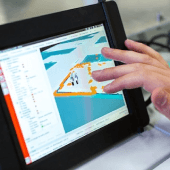Table of Content
- Introduction
- What is Non-Destructive Testing?
- What are the Non-Destructive Testing Methods?
- Ultrasonic Inspection
- Radiographic Inspection
- Key Takeaways
Introduction
All buildings have vital importance due to the loadings they endure in the usage process and external natural factors such as earthquakes, wind, and floods.
Most errors, such as plastic deformation and cracks that occur during construction or its use, are difficult to notice visually. However, some errors may occur in the invisible parts of the structures.
It becomes difficult to determine these faults in buildings; as a result, tests are performed with conventional methods, and it is risky to continue with the building in such conditions.
Especially in a region like Turkey, which is in an earthquake-prone zone with intense natural effects, the magnitude of the risk associated with building usage becomes even more apparent when combined with industrial activities.
In this context, ensuring that the production and construction of structures comply with the specified projects, including verifying their strength calculations and designs, is essential and mandatory.
Thus, carrying out Non-Destructive Testing (NDT) inspections during construction and their use is as significant as destructive inspections in buildings.
What is Non-Destructive Testing?
Non-Destructive Testing (NDT) is the name given to all inspection methods in which information about the dynamic and static structures of the examined piece is obtained without damaging the material.
Non-destructive testing has the following features;
- Multiple sensitive non-destructive tests can be conducted at once or in sequence on various parts and characteristics of an object, allowing for evaluating service performance and examining numerous features.
- By conducting a non-destructive inspection of a building, the structure can be thoroughly examined without causing any damage, ensuring it can still be safely utilized. This approach offers more reliable results compared to destructive inspections, which can lead to sampling problems and uncertainties about how well the sample represents the entire structure.
- Repeated application of non-destructive testing on the same area allows for monitoring of fatigue and damage development during the use of an object.
- Non-Destructive Testing (NDT) has moved the inspection work from the laboratory to the workshop. The NDT inspection process is carried out in the usage environment of the structures.
What are the Non-Destructive Testing Methods that can be applied to Buildings?
- Visual observation
- The electric potential method to determine the potential corrosion of iron in concrete
- Schmidt Hammer Test to evaluate the surface hardness of concrete
- Permeability Test to measure the flow of water in concrete
- Covermeter Test to determine the location of the iron in the concrete
- Radiographic Test
- Ultrasonic Test, which is based on the measurement of the sound velocity of the concrete to test the compressive strength of the concrete
- Other typical application methods such as ground radar measurements and infrared Thermography measurements.
Ultrasonic Inspection
Ultrasonic Testing is a modern non-destructive technique for analyzing solids, liquids, and gases.
Recent advancements in ultrasonic technology include super-high sensitivity, high frequency, and high-resolution capabilities.
These improvements have expanded the range of applications for Ultrasonic Testing. The advantages of this NDT Technique include the following:
- Determines mechanical properties and microstructure
- Used for imaging and microscope purposes
- Portable and cost-effective
- Applicable for all states of matter except plasma and vacuum
- Not affected by optical density
The vibration rate method has been widely used both in the field and laboratory, proving to be a successful tool in various applications.
One such application is the analysis of degradation in concrete, where the method is effective. Additionally, it is commonly used in quality control processes.
- Ultrasonic Inspection can detect the following features;
- Determination of Concrete Quality Directly from Vibration Rates
- Estimation of Concrete Strength
- Predicting the Homogeneity of Concrete
- Studies on the Hydration of Concrete
- Reflections on the Durability of Concrete
- Surface Fracture Depth
- Determination of Dynamic Modulus of Elasticity
Radiographic Inspection
The Radiographic Inspection method utilizes two types of rays, X-rays and gamma rays, to inspect materials.
Based on the principle of measuring the decrease in intensity of these rays as they pass through the material, information can be obtained about the presence, location, and size of cavities within the material.
Two techniques are commonly used for material inspection: radioscopy and radiography.
Radioscopy:
Radioscopy is a Non-Destructive Testing (NDT) technique that utilizes X-rays to inspect materials.
In this technique, X-rays interact with a fluorescent material, causing it to produce stains proportional to the intensity of the X-rays.
Dark spots on the material indicate that X-rays are less absorbed by it, indicating the presence of gaps or voids. This technique is known for its fast inspection capability.
Radiography:
Radiography is another Non-Destructive Testing (NDT) technique that utilizes X-rays.
This technique uses photographic plates to capture an image of the material being inspected.
The plates are placed in opaque cassettes that allow X-rays to pass through and expose the plates.
After the exposure, the plates are developed, and dark spots on the developed film indicate the presence of defects in the material.
This NDT Technique provides accurate information on the void state of concrete.
It can detect foreign objects, cracks, and voids and provide information on the quality of concrete and reinforcement in structures.
However, this technique requires expertise and is generally more expensive than other methods.
Key Takeaways
- Non-destructive inspection in structures refers to techniques used to assess the condition of a structure without causing any damage or permanent alteration.
- These techniques include ultrasonic inspection, radiography, thermography, and magnetic particle inspection.
- Non-destructive inspection allows for detecting hidden defects, such as cracks, voids, and corrosion, in structural components without the need for destructive testing.
- It is a valuable tool in ensuring the safety and longevity of structures such as buildings, bridges, and pipelines. It is widely used in industries such as construction, aerospace, and manufacturing.













